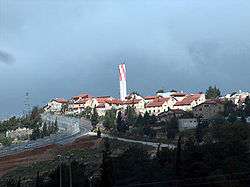Beit Horon
| Beit Horon | |
|---|---|
 | |
 Beit Horon | |
| Coordinates: 31°52′36.12″N 35°7′43.32″E / 31.8767000°N 35.1287000°ECoordinates: 31°52′36.12″N 35°7′43.32″E / 31.8767000°N 35.1287000°E | |
| District | Judea and Samaria Area |
| Council | Mateh Binyamin |
| Region | West Bank |
| Affiliation | Amana |
| Founded | 1977 |
| Population (2015)[1] | 1,228 |
Beit Horon (Hebrew: בֵּית חוֹרוֹן) is a communal Israeli settlement in the West Bank. Bordering Route 443 between Modi'in and Jerusalem, the biblical pass of Beit Horon (Joshua 10:10), after which it is named,[2] it falls under the jurisdiction of Mateh Binyamin Regional Council. In 2015 it had a population of 1,228.
The international community considers Israeli settlements in the West Bank illegal under international law, but the Israeli government disputes this.[3]
History
Beit Horon was established on 1 December 1977.[4] It is a joint Secular and Orthodox community.
A religious elementary school located in Beit Horon serves local children as well as those from surrounding villages. There are also three nurseries and kindergarten, two synagogues, a kollel, a mikvah for women and men, and a library.[5]
See also
References
- ↑ "List of localities, in Alphabetical order" (PDF). Israel Central Bureau of Statistics. Retrieved 16 October 2016.
- ↑ Carta's Official Guide to Israel and Complete Gazetteer to all Sites in the Holy Land. (3rd edition 1993) Jerusalem, Carta, p.112, ISBN 965-220-186-3 (English)
Bitan, Hanna: 1948-1998: Fifty Years of 'Hityashvut': Atlas of Names of Settlements in Israel, Jerusalem 1999, Carta, p.10, ISBN 965-220-423-4 (Hebrew) - ↑ "The Geneva Convention". BBC News. 10 December 2009. Retrieved 27 November 2010.
- ↑ "Israelis, Palestinians Share Fears As Talks Likely Delayed". Orlando Sentinel. July 23, 1995. Retrieved August 22, 2012.
- ↑ Beit Horon Archived July 27, 2011, at the Wayback Machine. Amana